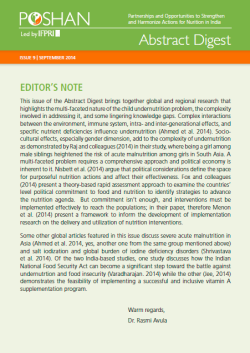 This issue of the Abstract Digest brings together global and regional research that highlights the multi-faceted nature of the child undernutrition problem, the complexity involved in addressing it, and some lingering knowledge gaps. Complex interactions between the environment, immune system, intra- and inter-generational effects, and specific nutrient deficiencies influence undernutrition (Ahmed et al. 2014). Sociocultural effects, especially gender dimension, add to the complexity of undernutrition as demonstrated by Raj and colleagues (2014) in their study, where being a girl among male siblings heightened the risk of acute malnutrition among girls in South Asia. A multi-faceted problem requires a comprehensive approach and political economy is inherent to it. Nisbett et al. (2014) argue that political considerations define the space for purposeful nutrition actions and affect their effectiveness. Fox and colleagues (2014) present a theory-based rapid assessment approach to examine the countries’ level political commitment to food and nutrition to identify strategies to advance the nutrition agenda. But commitment isn’t enough, and interventions must be implemented effectively to reach the populations; in their paper, therefore Menon et al. (2014) present a framework to inform the development of implementation research on the delivery and utilization of nutrition interventions. Some other global articles featured in this issue discuss severe acute malnutrition in Asia (Ahmed et al. 2014, yes, another one from the same group mentioned above) and salt iodization and global burden of iodine deficiency disorders (Shrivastava et al. 2014). Of the two India-based studies, one study discusses how the Indian National Food Security Act can become a significant step toward the battle against undernutrtion and food insecurity (Varadharajan. 2014) while the other (Jee, 2014) demonstrates the feasibility of implementing a successful and inclusive vitamin A supplementation program.
This issue of the Abstract Digest brings together global and regional research that highlights the multi-faceted nature of the child undernutrition problem, the complexity involved in addressing it, and some lingering knowledge gaps. Complex interactions between the environment, immune system, intra- and inter-generational effects, and specific nutrient deficiencies influence undernutrition (Ahmed et al. 2014). Sociocultural effects, especially gender dimension, add to the complexity of undernutrition as demonstrated by Raj and colleagues (2014) in their study, where being a girl among male siblings heightened the risk of acute malnutrition among girls in South Asia. A multi-faceted problem requires a comprehensive approach and political economy is inherent to it. Nisbett et al. (2014) argue that political considerations define the space for purposeful nutrition actions and affect their effectiveness. Fox and colleagues (2014) present a theory-based rapid assessment approach to examine the countries’ level political commitment to food and nutrition to identify strategies to advance the nutrition agenda. But commitment isn’t enough, and interventions must be implemented effectively to reach the populations; in their paper, therefore Menon et al. (2014) present a framework to inform the development of implementation research on the delivery and utilization of nutrition interventions. Some other global articles featured in this issue discuss severe acute malnutrition in Asia (Ahmed et al. 2014, yes, another one from the same group mentioned above) and salt iodization and global burden of iodine deficiency disorders (Shrivastava et al. 2014). Of the two India-based studies, one study discusses how the Indian National Food Security Act can become a significant step toward the battle against undernutrtion and food insecurity (Varadharajan. 2014) while the other (Jee, 2014) demonstrates the feasibility of implementing a successful and inclusive vitamin A supplementation program.


